Class Mammalia
Order Carnivora
Family Felidae
Panthera atrox—American Lion // Panthera onca—Jaguar
Synonyms. Felis.
Sometimes just known as the "big cats," Panthera includes such taxa as P. leo (the Old World Lion, often called the African Lion), P. tigris (Tiger), and the New World species P. atrox (American Lion) and P. onca (Jaguar).
Harris (1993c) recorded a queried identification of Panthera from Algerita Blossom Cave on the basis of a damaged metapodial. This is no longer considered a possible Panthera element, and the record is rescinded.
Literature:
The great cats are difficult to identify with certainty, especially on fragmentary
material. Panthera atrox is a fair bit larger than P. leo and fairly well
characterized for one region by a sample from Rancho La Brea (Merriam and Stock 1932).
Pleistocene examples of Panthera onca also are characterized by larger size than
found in the modern North American populations. The problem in our region is that some
specimens of large cats are somewhat intermediate in size between published
measurements of P. atrox and P. onca. Several of the identifications in
the accounts involving material in the collections of the UTEP Biodiversity Collections thus are based on playing the odds, so to speak.
Literature:
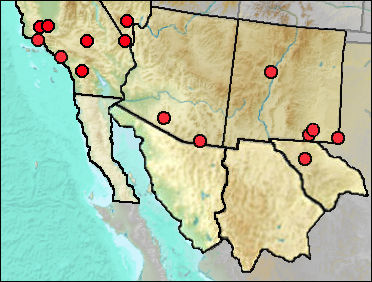
Synonyms. Felis atrox, Panthera leo atrox.
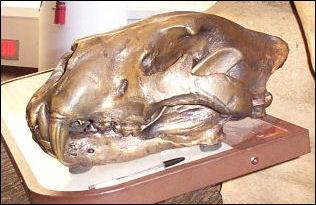 This
taxon has variously been considered an American subspecies of the Lion (P. leo,
often called the African Lion, which is a misnomer since it is not limited to Africa)
or as a separate species. Size not only was larger than P. leo, but P.
atrox was "one of the largest feline felids that ever existed"
(Christiansen and Harris 2009:943).
This
taxon has variously been considered an American subspecies of the Lion (P. leo,
often called the African Lion, which is a misnomer since it is not limited to Africa)
or as a separate species. Size not only was larger than P. leo, but P.
atrox was "one of the largest feline felids that ever existed"
(Christiansen and Harris 2009:943).
Fig. 1. Bronze replica of the skull of Panthera atrox, San Diego Natural History Museum. Photograph by "Erimus", Wikimedia Commons. Ballpoint pen by the skull for scale.
In a recent study, Christiansen and Harris (2009) extensively studied the skull and mandibular morphology of P. leo, P. tigris, P. onca, and P. atrox. The results indicate that P. atrox is indeed a species separate from the other great cats and descended from an early jaguar. They conclude (p. 943) that their "study suggests that the great cats of the Americas were relatives of the jaguar, and that the lion lineage never reached the American mainland, although it may have been present in Beringia."
On the other hand, Barnett et al. (2009) studied modern and Late Pleistocene mitochondrial DNA from modern lions from Asia and Africa; fossil cave lions (P. spelaea) from Europe, Asia, and eastern Beringia; and fossil American lions from the states of Alberta and Wyoming. They concluded that "All late Pleistocene lion samples produced sequences that grouped strongly with modern lion data ..., rejecting any postulated link between atrox and jaguar (Panthera onca)...." (p. 1670). They also found an absence of gene flow between the Beringian lions and those south of the ice sheets, as well as between P. spelaea and P. leo. They considered the species status of the three lion forms unresolved until nuclear DNA and morphological data are studied. However, the absence of gene flow between the three taxa suggests specific status, and that is the course followed here.
In common with so many other Late Pleistocene taxa, extinct occurred near the end of the epoch. Barnett et al. (2009) gave the latest direct date as 11,355 ± 55 BP on material from Edmonton, Canada.
Measurements for elements represented in material from our region has been greater augmented by permission from Kevin Seymour to use data from his extensive database. His data, data from Rancho La Brea (Merriam and Stock 1932), from Kurtén (1973), and measurements of some of the limited material at UTEP are given in this account.
Table 1. Comparative measurements (mm) of the radius of P. atrox, P. onca, and UTEP 41-62 from Isleta Cave No. 1.
| Element | Seymour (pers. commun.) | Merriam and Stock 1932 | Kurtén 1973 | UTEP 41-62 |
|---|---|---|---|---|
| Length of Radius | 297 | |||
| Length of Radius, P. atrox | 207-323 (n=10) | 317-411 (n=10) | ||
| Length of Radius, Modern P. onca | 153-236 (n=27) | |||
| Length of Radius, Fossil P. onca | 207-242 (n=20) | ~225-~244 (n=2) | ||
| Breadth Proximal End Radius | 42 | |||
| Breadth Proximal End Radius, P. atrox | 40.4-49.3 (n=10) | ~44-58.1 (n=10) | ||
| Breadth Proximal End Radius, Modern P. onca | 21.5-31.1 | |||
| Breadth Proximal End Radius, Fossil P. onca | 28.5-39.5 | 34.3-37.4 |
Based on the measurements in Table 1, UTEP 41-62 is identified as P. atrox.
A metacarpal IV from Isleta Cave No. 1 also seems clearly to be of P. atrox (Fig. 2). A distal diaphysis of a humerus of a young individual from the same site seems large enough to likely belong to the taxon.
A somewhat damaged astragalus (UTEP 41-63) from the same site appears to fall safely
into the P. atrox size range in greatest
length: UTEP 41-63, 58.3 mm; Seymour's data for P. atrox: 56.1 to 63.0 (n=6), for modern P. onca: 32.1-43.7 (n=19), and for fossil P. onca: 38.0-50.3 (n=12).
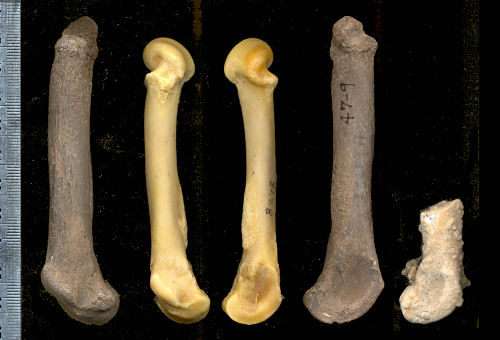
Fig. 2. Comparisons between metacarpal IVs of three species of Panthera. Left and fourth from left, medial and lateral views, P. atrox (UTEP 41-3434); second and third from left, same views, modern male P. leo; figure on right, proximal end, P. onca. The distal end of the metacarpal of P. atrox is missing, and the metacarpal of P. onca is covered with flowstone.
Table 2. Comparison of measurements (mm) of P3 of modern and fossil P. onca, P. atrox, and UTEP specimens from Pit N&W Animal Fair and Above the Room of the Vanishing Floor, Dry Cave.
| Element | Seymour (pers. commun.) | Merriam and Stock 1932 | Kurtén 1973 | UTEP Specimens |
|---|---|---|---|---|
| Length of P3 | 122-665 23.3 | |||
| Length of P3 | 27-48 20.5 | |||
| Length of P3, P. atrox | 23.4-30.6 (n=38) | 23.9-30.6 (n=14) | ||
| Length of P3, Modern P. onca | 14.6-22.1 (n=80) | 15.4-19.4 (n=12) | ||
| Length of P3, Fossil P. onca | 16.9-23.2 (n=34) | 16.9-22.3 (n=5) | ||
| Greatest Breadth of P3 | 122-665 13.4 | |||
| Greatest Breadth of P3 | 27-48 9.0 | |||
| Greatest Breadth of P3, P. atrox | 11.5-16.6 (n=38) | 12.0-16.2 (n=12) | ||
| Greatest Breadth of P3, Modern P. onca | 7.5-12.8 (n=80) | |||
| Greatest Breadth of P3, Fossil P. onca | 8.8-13.1 (n=34) |
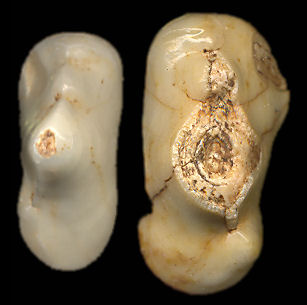 A P3 (Fig. 3,
Table 2) from the Pit N&W Animal Fair appears to be too large for
Smilodon, based on Merriam and Stock (1932), who unfortunately give alveolar
measurements rather than greatest tooth length. Between P. onca and P.
atrox, the UTEP specimen best fits the latter. The greater robustness compared
to that of P. onca can be seen in Fig. 3. The specimen from the Pit N&W
Animal Fair (UTEP 122-665) is that cited by Harris (1993c) as Panthera cf.
onca.
A P3 (Fig. 3,
Table 2) from the Pit N&W Animal Fair appears to be too large for
Smilodon, based on Merriam and Stock (1932), who unfortunately give alveolar
measurements rather than greatest tooth length. Between P. onca and P.
atrox, the UTEP specimen best fits the latter. The greater robustness compared
to that of P. onca can be seen in Fig. 3. The specimen from the Pit N&W
Animal Fair (UTEP 122-665) is that cited by Harris (1993c) as Panthera cf.
onca.
Fig. 3. Comparison of a right P3 (27-48, left) of Panthera onca from Above the Room of the Vanishing Floor, Dry Cave with that of UTEP 122-665, a left P3, from Pit N&W Animal Fair. (The depression on the upper left of the left image is a chip out of the enamel.)
Somewhere in the re-examination of specimens, the Room of the Vanishing Floor site got listed for this species; all the large cat remains from that site appear to be P. onca.
Sites.
Rancholabrean: Bitter Springs Playa (Jefferson 2014); Centinella Park (Jefferson 1991b: cf.); Jal (Morgan and Lucas 2005); Michigan St. (Jefferson 1991b); Piute Valley (Jefferson 1991b); Tule Springs 2 (Jefferson et al. 2015).
Sangamon: San Pedro Lumber Co. (Jefferson 1991b: cf.).
Wisconsin: Carpinteria (Wilson 1933: cf.).
Mid Wisconsin: McKittrick (Schultz 1937).
Mid/Late Wisconsin: Diamond Valley (Springer et al. 2009); Pit N&W Animal Fair (UTEP); Rancho La Brea (Stock and Harris 1992).
Mid/Late Wisconsin/Holocene: Sierra Diablo Cave (UTEP).
Late Wisconsin: Maricopa (Jefferson 1991b); Muskox Cave (Logan 1981); Pyeatt Cave (Mead et al. 2005); Ventana Cave (Colbert 1950).
Late Wisconsin/Holocene: Isleta Cave No. 1 (Harris 1993c).
Literature.
Barnett et al. 2009; Christiansen and Harris 2009; Colbert 1950; Harris 1993c; Jefferson 1991b, 2014; Jefferson et al. 2015; Kurtén 1973; Logan 1981; Mawby 1967; Mead et al. 2005; Merriam and Stock 1932; Morgan and Lucas 2005; Schultz 1937; Springer et al. 2009; Stock and Harris 1992; Wilson 1933.
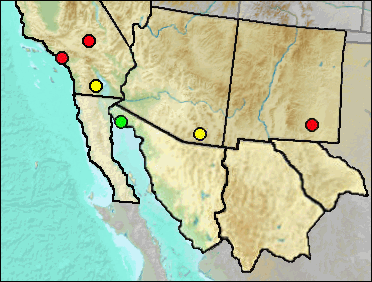
Synonyms. Felis onca.
Although parts of our region are within the current geographic range of the Jaguar, our area is at the northernmost margin of the distribution. During the Pleistocene, however, the range extended considerably farther north (Kurtén 1973, Seymour 1993). Seymour lists Irvingtonian localities that include sites in West Virginia, Pennsylvania, and Nebraska, among others. The range contracted during the Pleistocene; Kurtén lists late Pleistocene sites as Nevada, Kansas, Missouri, Tennessee, and Georgia. The Irvingtonian Jaguars were large, with the decrease in size through time concomitant with the decrease in geographic range.
Portions of two skulls plus some post-cranial material from the older deposits of Dry Cave clearly represent P. onca. One skull (27-48) is complete enough to allow some measurements (Table 1) that can be compared to measurements of fossil Jaguar skulls given by Kurtén (1973).
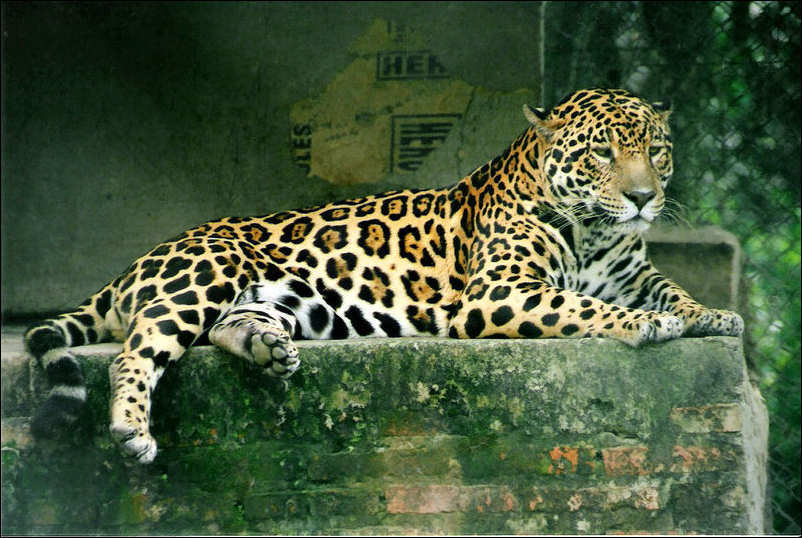
Fig. 1. Panthera onca. Description: A wildlife rescue & rehabilitation centre in Formosa Province, Argentina. August, 1998. Photographer: Lea Maimone. Permission: This image is released by the photographer under a Creative Commons license. This file is licensed under the Creative Commons Attribution ShareAlike 2.5 License. In short: you are free to share and make derivative works of the file under the conditions that you appropriately attribute it, and that you distribute it only under a license identical to this one. Official license.
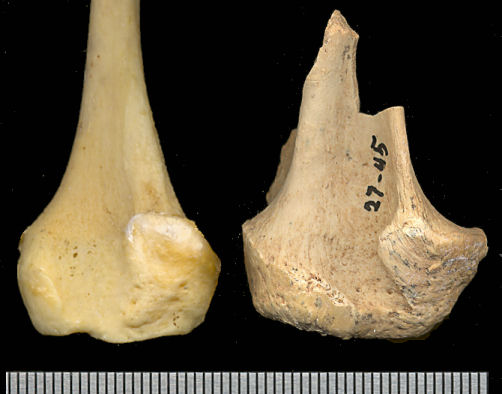 The proximal end of a fibula is smaller (long diameter of proximal end 27.86
mm compared to 35.4 mm) than the single specimen of P. atrox cited by Merriam and Stock
(1932). This specimen is part of a series from Site 4 within site 27; since all others
appear to be of the same individual represented by the partial skull and dentition from
the site, it is identified as P. onca. As can be seen in Fig. 2, size is considerably
larger than in a specimen of P. tigris.
The proximal end of a fibula is smaller (long diameter of proximal end 27.86
mm compared to 35.4 mm) than the single specimen of P. atrox cited by Merriam and Stock
(1932). This specimen is part of a series from Site 4 within site 27; since all others
appear to be of the same individual represented by the partial skull and dentition from
the site, it is identified as P. onca. As can be seen in Fig. 2, size is considerably
larger than in a specimen of P. tigris.
Fig. 2. Comparison of the proximal end of the left fibula of Panthera tigris (left) and UTEP fossil 27-45.
Table 1. Comparison of skull measurements of UTEP 27-48 with fossil Panthera onca measurements (Kurtén 1973). Measurements in mm. Figures in parentheses are the number of skulls used to construct the range.
| Measurement | UTEP 27-48 | Kurtén (1973) |
|---|---|---|
| Mastoid Width | 114.4 | 104-126 (3) |
| Bicondylar Length | 54.3 | 52-56 (4) |
| Occipital height | 83.2 | 82-91 (2) |
Sites.
Late Blancan: Anza-Borrego (Shaw and Cox 2006); Curtis Ranch (Lindsay 1984).
Irvingtonian: El Golfo (Croxen et al. 2007: cf.).
Irvingtonian/Rancholabrean: Fort Irwin (Jefferson 1991b).
Early/Early-Mid Wisconsin: Rm Vanishing Floor (Harris 1993c); South Chimney, Dry Cave (Harris 1993c); Rancho La brea (Stock and Harris19920.
Literature:
Croxen et al. 2007; Harris 1993c; Kurtén 1973; Lindsay 1984; Merriam and Stock 1932; Seymour 1993; Shaw and Cox 2006; Stock and Harris 1992).
Last Update: 14 May 2015